As you work through this slide lecture, click on the thumbnails to enlarge
the images.
Monarchy and Dynasties: At the apex of
the Georgian world was the crown, the symbol of sovereignty.
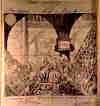 What does this
admission ticket to the coronation of George III reveal about the English monarchy and its
place in British patriotism in the mid 18th century? Note the letters SPQB.
What do you think it means and why is it
there?
What does this
admission ticket to the coronation of George III reveal about the English monarchy and its
place in British patriotism in the mid 18th century? Note the letters SPQB.
What do you think it means and why is it
there?
 George III with
the queen and children. This portrait shows the dynasty, the greatest of the
aristocratic
families. Georgian society was hierarchical with the nobility at the top.
What does this
portrait suggest about aristocratic society and its values?
George III with
the queen and children. This portrait shows the dynasty, the greatest of the
aristocratic
families. Georgian society was hierarchical with the nobility at the top.
What does this
portrait suggest about aristocratic society and its values?
 Portrait (by Gilbert Stuart) of
John Lord
Fitzgibbon, the
Lord Chancellor, head of the justice system. . The monarch was not just at the social apex. He was also the supreme
governor of the realm. Officers of government ruled in his name. Note the way this baroque
portrait uses symbols of majesty. List them.
Portrait (by Gilbert Stuart) of
John Lord
Fitzgibbon, the
Lord Chancellor, head of the justice system. . The monarch was not just at the social apex. He was also the supreme
governor of the realm. Officers of government ruled in his name. Note the way this baroque
portrait uses symbols of majesty. List them.
The Aristocracy
 Joshua Reynolds
(1723-1792) painted this family portrait of one of England's noble families about
1778. Some noble families were around since the middle ages and others, like the
Churchills (Dukes of Marlborough) were of more recent origins. The first Duke was
ennobled
for his military victory against Louis XIV of France at the
Battle of Blenheim in 1704.
This upper echelon of the social hierarchy had titles and great estates. Compare
this portrait with the one of the royal family. What does this image add
to your understanding of aristocratic values?
Joshua Reynolds
(1723-1792) painted this family portrait of one of England's noble families about
1778. Some noble families were around since the middle ages and others, like the
Churchills (Dukes of Marlborough) were of more recent origins. The first Duke was
ennobled
for his military victory against Louis XIV of France at the
Battle of Blenheim in 1704.
This upper echelon of the social hierarchy had titles and great estates. Compare
this portrait with the one of the royal family. What does this image add
to your understanding of aristocratic values?
 The traditional source of wealth for the aristocracy was land. Their great estates
provided income. This estate with its enormous baroque palace in Oxfordshire was presented
to
John Churchill,
the first Duke of Marlborough, for his services to the crown. Service
to the dynastic state was the route to prestige and fortune for the ambitious. Notice the
major features of baroque architecture in this building: large size, symmetry, classical
motifs, ornamentation.
The traditional source of wealth for the aristocracy was land. Their great estates
provided income. This estate with its enormous baroque palace in Oxfordshire was presented
to
John Churchill,
the first Duke of Marlborough, for his services to the crown. Service
to the dynastic state was the route to prestige and fortune for the ambitious. Notice the
major features of baroque architecture in this building: large size, symmetry, classical
motifs, ornamentation.
 Estates like Blenheim had huge tracts of land. Here the stone monument carries a statue of
the first Duke. Notice the grazing sheep. Wool had been an important product for the
textile trade since the Middle Ages. By the 18th century large landholders were fencing
off some of their fields, traditionally open for poorer farmers, to raise sheep for more
profitable agriculture, a movement known as
Enclosure. It meant more income for the landlords and greater hardship for
small farmers. In Georgian England 400 great families owed about 25% of the land.
Estates like Blenheim had huge tracts of land. Here the stone monument carries a statue of
the first Duke. Notice the grazing sheep. Wool had been an important product for the
textile trade since the Middle Ages. By the 18th century large landholders were fencing
off some of their fields, traditionally open for poorer farmers, to raise sheep for more
profitable agriculture, a movement known as
Enclosure. It meant more income for the landlords and greater hardship for
small farmers. In Georgian England 400 great families owed about 25% of the land.
 From
the late 17th century wars for empire added glory to the
crown, wealth to the kingdom, opportunities for service by the
aristocracy, and avenues to advancement for the ambitious. In the contest
between the two great 18th-century contenders for empire, France and England, the
Battle or Quebec gave the advantage to England. This illustration, unfortunately not
distinct, shows the Royal navy in the St Lawrence River just below Quebec. French Canada
was added to the North American provinces of the British Empire. Provincials in English
America as well as people at the metropolitan center in England were proud of such
victories.
From
the late 17th century wars for empire added glory to the
crown, wealth to the kingdom, opportunities for service by the
aristocracy, and avenues to advancement for the ambitious. In the contest
between the two great 18th-century contenders for empire, France and England, the
Battle or Quebec gave the advantage to England. This illustration, unfortunately not
distinct, shows the Royal navy in the St Lawrence River just below Quebec. French Canada
was added to the North American provinces of the British Empire. Provincials in English
America as well as people at the metropolitan center in England were proud of such
victories.
 Death of General Wolfe at the
Battle of Quebec (1759) painted by
Benjamin
West (1738-1820) in
1771. Note the theme of heroism and service conveyed by this painting of the
historical event. Note also the assortment of characters in the painting.
Death of General Wolfe at the
Battle of Quebec (1759) painted by
Benjamin
West (1738-1820) in
1771. Note the theme of heroism and service conveyed by this painting of the
historical event. Note also the assortment of characters in the painting.
Metropolitan Center
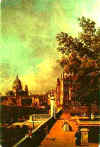 Thames Embankment about
1750, one of Canaletto
cityscapes. London, the largest city in the world by the mid 18th century, was the seat of
government, the social and cultural center, and the heart of commerce. This scene shows
the great Thames with its Embankment for fashionable strolling. Note the dome of
St Paul's
Cathedral in the background.
Thames Embankment about
1750, one of Canaletto
cityscapes. London, the largest city in the world by the mid 18th century, was the seat of
government, the social and cultural center, and the heart of commerce. This scene shows
the great Thames with its Embankment for fashionable strolling. Note the dome of
St Paul's
Cathedral in the background.
 St. Paul's Cathedral, facade:
Sir Christopher Wren build this outstanding example of
baroque religious architecture.
How many features of baroque architecture can you find here?
St. Paul's Cathedral, facade:
Sir Christopher Wren build this outstanding example of
baroque religious architecture.
How many features of baroque architecture can you find here?
 St. Paul's Cathedral, nave
St. Paul's Cathedral, nave
 St. James Park: The
aristocracy and gentry enjoy the delights of this park. Can you find the towers of
Westminster
Abbey in the background?
St. James Park: The
aristocracy and gentry enjoy the delights of this park. Can you find the towers of
Westminster
Abbey in the background?
 Mr. &Mrs. Andrews by Thomas
Gainsborough(1727-1788): Below the titled aristocracy were great merchants and landowners. This
group, the gentry, copied the style of the titled nobility by buying estates and living as
grandly as possible, even if their fortunes were made in commerce.
Mr. &Mrs. Andrews by Thomas
Gainsborough(1727-1788): Below the titled aristocracy were great merchants and landowners. This
group, the gentry, copied the style of the titled nobility by buying estates and living as
grandly as possible, even if their fortunes were made in commerce.
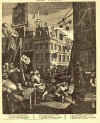 Beer Street, William
Hogarth(1697-1764): Hogarth
was a chronicler of the varied social scenes of Georgian England. Here is a part of London
for the middling sort, shopkeepers, artisans etc. Note the
bustling, crowded, commercial street life.
Beer Street, William
Hogarth(1697-1764): Hogarth
was a chronicler of the varied social scenes of Georgian England. Here is a part of London
for the middling sort, shopkeepers, artisans etc. Note the
bustling, crowded, commercial street life.
 Gin Lane, William Hogarth: This image
brings us to a part of London for the lower sort, the bottom of the
social heap, the unemployed, homeless, dropout. Slum conditions, grinding poverty,
disease, death, addiction form the background for the woman who is about to lose her child
as she dips into narcotics.
Gin Lane, William Hogarth: This image
brings us to a part of London for the lower sort, the bottom of the
social heap, the unemployed, homeless, dropout. Slum conditions, grinding poverty,
disease, death, addiction form the background for the woman who is about to lose her child
as she dips into narcotics.

PROVINCES
Cities: Provincial Centers of Empire
 New York City about 1717. The
colonial seaports were crucial to the trade that bound the mercantilist Empire
to the metropolitan center.
New York City about 1717. The
colonial seaports were crucial to the trade that bound the mercantilist Empire
to the metropolitan center.
 Philadelphia, 1762 : The largest
city in English America by the mid 18th century. Notice the differences between this city
and London's street scenes.
Philadelphia, 1762 : The largest
city in English America by the mid 18th century. Notice the differences between this city
and London's street scenes.
The Crown in the Provinces
 Governors Palace, Williamsburg:
The crown was represented in royal colonies like Virginia by the Governor. This building
is a good example of
Georgian architecture
in the colonies. It is plainer
and on a smaller scale than the great baroque public buildings in England. Nonetheless, it
is graceful in proportion, harmonious and symmetrical in form, and beautifully ornamented.
Governors Palace, Williamsburg:
The crown was represented in royal colonies like Virginia by the Governor. This building
is a good example of
Georgian architecture
in the colonies. It is plainer
and on a smaller scale than the great baroque public buildings in England. Nonetheless, it
is graceful in proportion, harmonious and symmetrical in form, and beautifully ornamented.
 Bruton Parish Church; The
Church of England (Anglican/Episcopal) was established in Britain (except Scotland) and in
Virginia and all the other southern colonies. The king was the supreme governor of the
Church and the bishops its spiritual leaders. This church in Williamsburg is another fine
example of Georgian architecture, symbol here of the connection between church and state
under royal protection and patronage.
Bruton Parish Church; The
Church of England (Anglican/Episcopal) was established in Britain (except Scotland) and in
Virginia and all the other southern colonies. The king was the supreme governor of the
Church and the bishops its spiritual leaders. This church in Williamsburg is another fine
example of Georgian architecture, symbol here of the connection between church and state
under royal protection and patronage.
 Bruton Church, interior Its
interior, here shown only in part, was a place where all segments of the social hierarchy
came. The royal governor and councilmen had the pews closest to the pulpit,
shown here.
Prominent families had the next choicest pews with more modest people farther back.
Servants and slaves used the balconies. Thus the arrangement in this Georgian church
reflected the social hierarchy
Bruton Church, interior Its
interior, here shown only in part, was a place where all segments of the social hierarchy
came. The royal governor and councilmen had the pews closest to the pulpit,
shown here.
Prominent families had the next choicest pews with more modest people farther back.
Servants and slaves used the balconies. Thus the arrangement in this Georgian church
reflected the social hierarchy

Provincial Elite: Because the titled
aristocracy was absent in colonial America, the social hierarchy was truncated. In the
South the planters were at the social apex; in the North the merchants
held the elite position.
 Mount Airey: Planters, their
wealth based on commercial agriculture, patterned their estates after the landed
gentry of England. This Virginian plantation shows the marks of Georgian
architecture with
its symmetry and balance. The planter's style of life as well as the demands of commercial
agriculture frequently meant reliance on credit.
Mount Airey: Planters, their
wealth based on commercial agriculture, patterned their estates after the landed
gentry of England. This Virginian plantation shows the marks of Georgian
architecture with
its symmetry and balance. The planter's style of life as well as the demands of commercial
agriculture frequently meant reliance on credit.
 Carter's Grove, bedroom ; What does the furniture in this Virginian
plantation tell you
about trade networks as well as the life style of the planter gentry?
Carter's Grove, bedroom ; What does the furniture in this Virginian
plantation tell you
about trade networks as well as the life style of the planter gentry?
 Derby House, Salem Mass., 1761,
an example of
Georgian
Colonial architecture. In Massachusetts and elsewhere in the north merchants were the leaders of society.
Their wealth was based on trade. This townhouse is another example of the
provincial American Georgian style.
Derby House, Salem Mass., 1761,
an example of
Georgian
Colonial architecture. In Massachusetts and elsewhere in the north merchants were the leaders of society.
Their wealth was based on trade. This townhouse is another example of the
provincial American Georgian style.
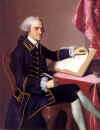 John Hancock, 1765 by
John
Singleton Copley,
Hancock, one of America's wealthiest merchants, made a fortune during the French and
Indian War. What does this portrait suggest about his values? Copley (1738-1815)
a major colonial American painter did a portrait of Paul Revere, became
a Loyalist and left for England when the Revolution appeared
threatening.
John Hancock, 1765 by
John
Singleton Copley,
Hancock, one of America's wealthiest merchants, made a fortune during the French and
Indian War. What does this portrait suggest about his values? Copley (1738-1815)
a major colonial American painter did a portrait of Paul Revere, became
a Loyalist and left for England when the Revolution appeared
threatening.
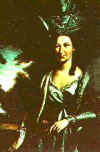 Mrs. Robert Morris, 1782, by
Charles
Willson Peale (1741-1827). This portrait of an important merchant's wife reflects the style of
the colonial gentry. Make careful note of her clothing. What does it tell you about trade
in the Georgian world?
Mrs. Robert Morris, 1782, by
Charles
Willson Peale (1741-1827). This portrait of an important merchant's wife reflects the style of
the colonial gentry. Make careful note of her clothing. What does it tell you about trade
in the Georgian world?

The Middling Sort: Shopkeepers,
artisans and tradesmen, in towns and cities, modest independent farmers in the rural
areas.
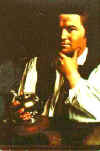 Paul Revere by Copley: This
portrait shows the famous Boston patriot as an artisan, a silversmith. Note the difference with the
Hancock portrait. Here he holds an example of his handiwork and is shown in shirtsleeves.
Paul Revere by Copley: This
portrait shows the famous Boston patriot as an artisan, a silversmith. Note the difference with the
Hancock portrait. Here he holds an example of his handiwork and is shown in shirtsleeves.
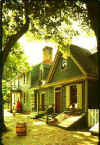 Silversmith House, Williamsburg:
Artisans' trade or craft gave them independence. They lived in houses like this one in
Williamsburg with a shop in the front, workshop in the rear and family living area above
in the back.
Silversmith House, Williamsburg:
Artisans' trade or craft gave them independence. They lived in houses like this one in
Williamsburg with a shop in the front, workshop in the rear and family living area above
in the back.
 American Farm, Pennsylvania: An
idyllic image of a prosperous farm providing a family a decent living with a surplus
for the market.
American Farm, Pennsylvania: An
idyllic image of a prosperous farm providing a family a decent living with a surplus
for the market.
 Bethlehem, Pa., 1757: [founded
1750] The frontiers presented opportunities fop independence. Notice how forests have been
cleared and fields planted in a short time.
Bethlehem, Pa., 1757: [founded
1750] The frontiers presented opportunities fop independence. Notice how forests have been
cleared and fields planted in a short time.
 American
Yeoman: This
idealized image of the independent farmer expresses what became an American ideal boosted
by Jefferson and others.
American
Yeoman: This
idealized image of the independent farmer expresses what became an American ideal boosted
by Jefferson and others.

The Lower Sort: Dependent Labor was
the key point. In the cities and towns this group included people working for others, people
making meager wages and the unemployed, In the rural
areas there were tenant farmers and the landless. At the
bottom of this social hierarchy, of course, were the slaves, examples of total dependence.